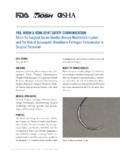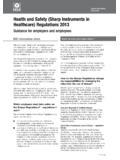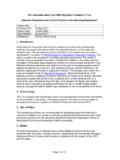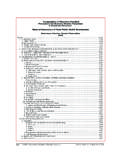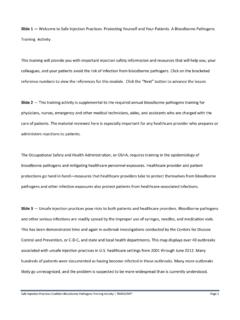Transcription of How to Prevent Needlestick and Sharps Injuries
1 Needlestick and other Sharps Injuries are a serious hazard in any healthcare setting. Contact with contaminated needles, scal-pels, broken glass, and other Sharps may expose healthcare workers to blood that contains pathogens which pose a grave, potentially lethal WITH POTENTIAL FOR Needlestick Injuries Home healthcare workers can be at risk for Needlestick or Sharps Injuries when they: Handle needles that must be taken apart or manipulated after use. Dispose of needles attached to tubing. Manipulate the needle in the client. Recap a needle. Use needles or glass equipment to transfer body fluid between containers. Fail to dispose of used needles in puncture-resistant Sharps containers. Lack proper workstations for procedures using Sharps . Work quickly. Bump into a needle, a sharp , or another worker while either person is holding a SHOULD Establish a bloodborne pathogen control program that meets all of the requirements of the OSHA bloodborne pathogens standard ( ).
2 Eliminate the use of needle devices whenever safe and effective alternatives are available. Provide needle devices with safety features. Provide Sharps containers for workers to bring into clients homes. Investigate all Sharps -related Injuries . Provide post-exposure medical SHOULD Avoid using needles whenever safe and effective alternatives are available. Avoid recapping or bending needles that might be to Prevent Needlestick and Sharps Injuries Bring standard-labeled, leak-proof, puncture-resistant Sharps containers to clients homes. Do not assume such containers will be available there. Promptly dispose of used needle devices and Sharps , which might be contaminated, in the containers. Plan for the safe handling and disposal of needles before use. Store Sharps containers out of the reach of children, pets, and others not needing access. Secure used Sharps containers during transport to Prevent spilling.
3 Follow standard precautions, infection prevention, and general hygiene practices consistently. Participate in your employer s bloodborne pathogens training program. Help your employer select and evaluate devices with safety features. Use devices with safety features provided by your employer. Report any Needlestick and other Sharps injury immediately to your employer. If you experience a Needlestick or Sharps injury or are exposed to the blood or other body fluid of a client during the course of your work, immediately follow these steps: Wash needlesticks and cuts with soap and water. Flush splashes to the nose, mouth, or skin with water. Irrigate eyes with clean water, saline, or sterile irrigants. Report the incident to your supervisor. Immediately seek medical OF HEALTH AND HUMAN SERVICESC enters for Disease Control and Prevention National Institute for Occupational Safety and Health TTelephone: 1 800 CDC INFO | TTY: 1 888 232 6348 Email: | Web: (NIOSH) Publication No.
4 2012 123 February 2012 Safer - Healthier - People This is one in a series of six fast fact cards developed to provide practical advice for home healthcare workers and is based on NIOSH Hazard Review: Occupational Hazards in Home Healthcare, NIOSH Pub No. 2010 125.










